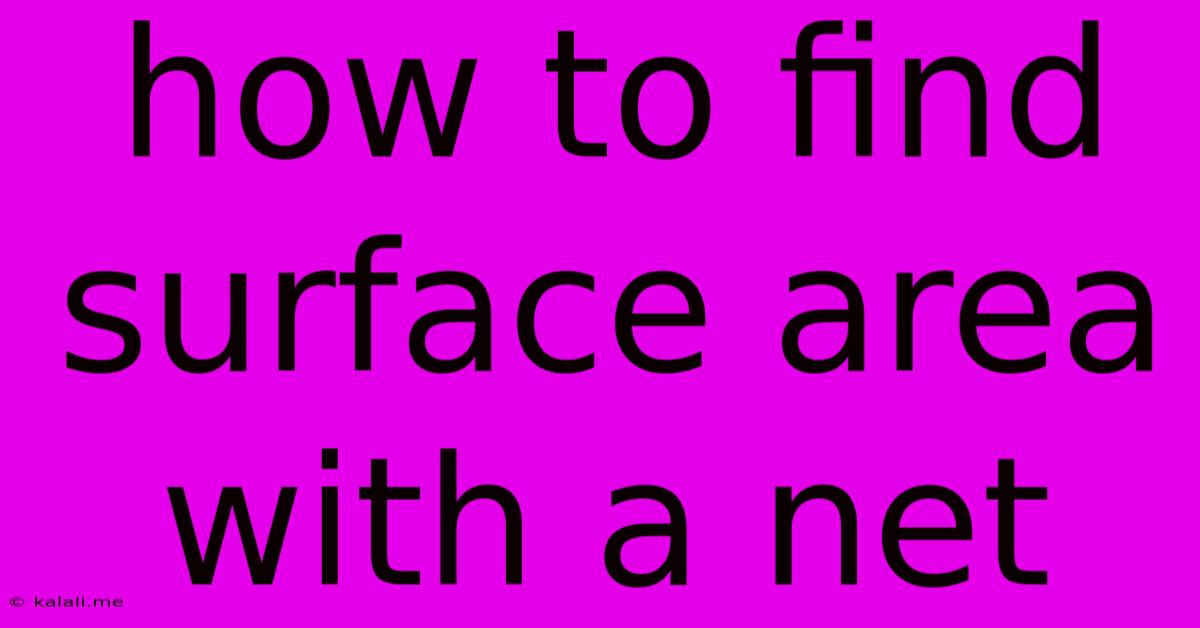How To Find Surface Area With A Net
Kalali
May 10, 2025 · 4 min read

Table of Contents
How to Find Surface Area Using a Net: A Comprehensive Guide
Finding the surface area of three-dimensional shapes can be tricky, but using nets simplifies the process significantly. A net is a two-dimensional representation of a three-dimensional shape, showing all its faces laid out flat. This article will guide you through calculating surface area using nets, covering various shapes and providing helpful tips. Understanding this method will significantly improve your understanding of geometry and surface area calculations.
What is a Net?
Before diving into calculations, let's clarify what a net is. Imagine unfolding a cardboard box. The flattened shape you get is a net. It shows all the faces of the box—its length, width, and height—arranged in a single plane. Similarly, nets exist for various three-dimensional shapes like cubes, rectangular prisms, triangular prisms, pyramids, and cylinders. Each face of the 3D shape is represented as a separate polygon in the net.
Calculating Surface Area Using Nets: Step-by-Step Guide
The process of finding surface area using a net involves these key steps:
-
Identify the Shape and its Net: First, determine the type of three-dimensional shape you're working with (e.g., cube, rectangular prism, triangular prism, pyramid). Then, draw or visualize its net. Accurately drawing the net is crucial for accurate calculations. Make sure all the faces are correctly represented.
-
Measure Each Face: Carefully measure the dimensions of each face in the net. This typically involves measuring the length and width (or base and height, depending on the shape) of each polygon. Record these measurements; accurately measuring each face is essential for obtaining an accurate surface area. Remember to use consistent units (e.g., centimeters, inches).
-
Calculate the Area of Each Face: Use the appropriate formula to calculate the area of each individual face. For squares and rectangles, the area is length x width. For triangles, it's (1/2) x base x height. For other polygons, you might need to break them down into smaller shapes to calculate the area.
-
Add the Areas Together: Once you have the area of each face, sum up all the individual areas. The total sum represents the total surface area of the three-dimensional shape.
Examples: Finding Surface Area Using Nets
Let's illustrate this with examples:
Example 1: Rectangular Prism
A rectangular prism's net typically consists of six rectangles. If the dimensions are length = 5 cm, width = 3 cm, and height = 2 cm, the calculation would be:
- Area of top and bottom faces: 2 x (5 cm x 3 cm) = 30 cm²
- Area of front and back faces: 2 x (5 cm x 2 cm) = 20 cm²
- Area of left and right faces: 2 x (3 cm x 2 cm) = 12 cm²
- Total Surface Area: 30 cm² + 20 cm² + 12 cm² = 62 cm²
Example 2: Triangular Prism
A triangular prism's net includes two congruent triangles and three rectangles. Measure the base and height of the triangles and the lengths and widths of the rectangles. Calculate the area of each individual shape and sum them to obtain the total surface area.
Example 3: Square Pyramid
A square pyramid's net includes one square base and four congruent triangles. Calculate the area of the square base and the area of each triangle separately. Summing these areas will yield the total surface area of the pyramid.
Tips for Success
- Use Graph Paper: Using graph paper can help you draw accurate nets, especially for complex shapes.
- Label Your Measurements: Clearly labeling your measurements on the net will prevent confusion during calculations.
- Check Your Work: Always double-check your calculations to ensure accuracy.
- Use a Calculator: A calculator can be helpful for more complex calculations, especially when dealing with decimals.
- Break Down Complex Shapes: If a shape's net is complex, break it down into smaller, simpler shapes to calculate the area of each part.
Using nets to find surface area provides a visual and methodical approach to this important geometrical concept. By following these steps and practicing with different shapes, you can master this technique and confidently calculate the surface area of various three-dimensional objects. Remember, accuracy in measurements and calculations is key to achieving the correct result.
Latest Posts
Latest Posts
-
Where Is The 3 In Riddle Transfer
Jul 03, 2025
-
How Much Does A Water Bottle Weight
Jul 03, 2025
-
How Many Inches Is Half A Yard
Jul 03, 2025
-
How Old Are You If Your Born In 1996
Jul 03, 2025
-
How Many Water Bottles In 64 Ounces
Jul 03, 2025
Related Post
Thank you for visiting our website which covers about How To Find Surface Area With A Net . We hope the information provided has been useful to you. Feel free to contact us if you have any questions or need further assistance. See you next time and don't miss to bookmark.